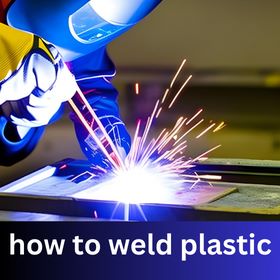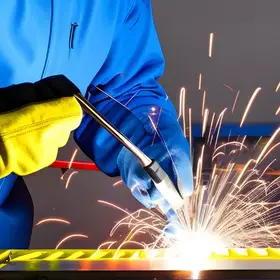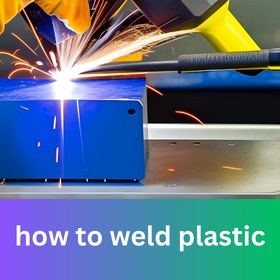Table of Contents
Plastic welding is a valuable skill that allows you to join plastic pieces together, creating strong and durable bonds. Whether you are a DIY enthusiast, a hobbyist, or a professional, learning how to weld plastic can open up a world of possibilities. In this comprehensive guide, we will take you through the step-by-step process of welding plastic, covering the essential techniques, tools, safety precautions, and tips for successful welds.
Understanding Plastic Welding
Plastic welding is a process that involves heating the surfaces of plastic pieces to their melting point and then pressing them together to form a cohesive bond. This method is particularly useful for repairing damaged plastics, fabricating plastic parts, and creating airtight seals.
Types of Plastic Welding Techniques
Various plastic welding techniques cater to different applications and plastic types. Butt welding is suitable for flat plastic pieces, while socket welding is ideal for cylindrical or tubular plastics. Extrusion welding is perfect for large surfaces and crack repairs, whereas hot gas welding provides versatility for various plastic types.
Tools and Materials
Before embarking on your plastic welding journey, gather the necessary tools and materials. Choose a reliable heat gun or welding iron, ensuring it offers precise temperature control. Select plastic welding rods that match the material of the plastic pieces you intend to weld. Don’t forget essential safety equipment like gloves and goggles to protect yourself from potential hazards.
Preparing for Plastic Welding
To achieve successful welds, proper preparation is essential. Start by cleaning the surfaces of the plastic pieces thoroughly to remove any dust, debris, or contaminants. Secure the pieces together using clamps or fixtures in the proper alignment, commonly known as “tacking,” before proceeding with the welding process.
Plastic Welding Techniques
Different plastic welding techniques cater to specific applications:
Butt Welding
Butt welding involves heating the edges of two flat plastic pieces and joining them together. This technique is useful for creating straight seams and connecting large flat surfaces.
Socket Welding
Socket welding is ideal for joining cylindrical or tubular plastic pieces. One end of the plastic is heated to create a socket, into which the second piece is inserted and welded.
Extrusion Welding
Extrusion welding is excellent for repairing cracks and joining larger areas of plastic. A plastic welding rod is fed into the welding gun, melted, and extruded onto the joint.
Hot Gas Welding
Hot gas welding utilizes a stream of heated gas, usually nitrogen or hot air, to melt the surfaces of the plastic pieces, which are then pressed together to form a strong bond. It is a versatile method suitable for various plastic types.
The Welding Process
Now that you have your tools and materials ready, it’s time to start the welding process.
Step 1: Setting up the Welding Equipment
Ensure your workspace is well-ventilated and set up your welding equipment on a stable surface. Check that the heat gun or welding iron is at the correct temperature for the specific plastic type you are working with.
Step 2: Applying Heat to the Plastic Pieces
Hold the heat gun or welding iron at a consistent distance from the plastic surface, moving it in a slow and steady motion. As the plastic heats up, it will start to soften and become glossy.
Step 3: Fusing and Cooling the Weld
Once the plastic surfaces are adequately heated, carefully press the pieces together, aligning them properly. Apply gentle pressure to fuse the softened plastic. Allow the weld to cool and solidify, ensuring a strong and durable bond.
Tips for Successful Plastic Welds
Achieving high-quality plastic welds requires attention to detail and practice. Consider the following tips:
Maintaining Optimal Welding Temperature
Different plastic types have varying melting points. Adjust the temperature of your heat gun or welding iron accordingly to achieve the optimal welding temperature for the specific plastic you are working with.
Controlling Welding Speed and Pressure
Maintain a consistent welding speed and pressure to ensure even melting and proper fusion. Experiment with different speeds and pressures to find the most effective combination for your specific plastic and welding technique.
Choosing the Right Welding Rods
Select welding rods made from the same material as the plastic you are working with. Using compatible welding rods ensures a stronger bond and reduces the risk of cracks or failures in the weld.
Safety Precautions
Working with plastic welding requires attention to safety to protect yourself and your workspace from potential hazards.
Proper Ventilation and Working Environment
Ensure that you work in a well-ventilated area to avoid inhaling harmful fumes and gases generated during the welding process. Additionally, keep flammable materials away from the welding area to prevent accidents.
Protection from Harmful Fumes and Sparks
Wear appropriate safety gear, such as gloves, goggles, and protective clothing, to shield yourself from potential burns and exposure to hazardous fumes and sparks.
Can I Weld Hard Plastic Back Together?
Hard plastics, such as ABS and polycarbonate, can be effectively welded back together using the appropriate plastic welding technique. However, it’s essential to pay attention to the specific type of hard plastic and select the correct welding method and materials for optimal results.
Can You Weld Plastic to Plastic?
Yes, it is possible to weld plastic to plastic. By using compatible plastic welding techniques and materials, you can create strong and reliable bonds between different plastic pieces.
What Type of Plastic Cannot be Welded?
Some plastics cannot be effectively welded due to their composition and melting points. For instance, polyethylene (PE) and polypropylene (PP) have high melting points, making them challenging to weld. Additionally, thermoset plastics, such as epoxy and phenolic resins, cannot be welded as they undergo irreversible chemical changes when heated.
Conclusion
Unlock the secrets of plastic welding guide. Learning how to weld plastic opens up a world of opportunities for repairs, fabrication, and creative projects. By following the step-by-step guide and applying the tips and safety precautions provided, you can achieve successful plastic welds that are strong, durable, and long-lasting. Remember to select the appropriate plastic welding technique and materials based on the type of plastic you are working with. Practice and patience will lead to improved skills and confidence in plastic welding.
FAQs
Q1: Can I weld different types of plastics together?
Answer: It is generally recommended to weld similar types of plastics together for the strongest bonds. However, there are specialized welding techniques and materials available for joining dissimilar plastics under certain circumstances.
Q2: Can I use a regular soldering iron for plastic welding?
Answer: While it is possible to use a soldering iron for some small-scale plastic welding tasks, it is not ideal for larger or more complex projects. Investing in a dedicated plastic welding tool will yield better results and versatility.
Q3: Is plastic welding suitable for all types of plastic repairs?
Answer: Plastic welding is an excellent technique for many plastic repairs, but there are instances where adhesive bonding or mechanical fastening may be more appropriate, depending on the nature of the damage and the plastic involved.
Q4: How do I choose the right plastic welding rod for my project?
Answer: Select a plastic welding rod that matches the material of the plastic you are working with. If unsure about the type of plastic, consult a professional or conduct a compatibility test before proceeding.
Q5: Can I use a heat gun instead of a welding iron for plastic welding?
Answer: Yes, a heat gun can be used for plastic welding. However, a welding iron may offer better control and precision, especially for intricate welding tasks.










